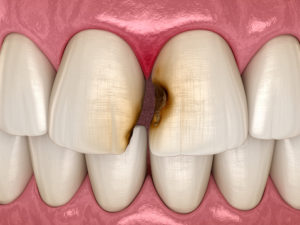What are the periodontal disease treatment options?
Gum disease is a progressive disease starting with gingivitis. When gingivitis is left untreated, gingivitis will progress to periodontal disease. Bacterial plaque builds beneath the gum line produces toxins irritating the gum and destroys the bone and supporting tissue. This eventually leads to premature tooth loss. When a dentist informs a patient they have periodontal disease, a patient will often ask if periodontal disease is curable?
How is periodontal disease treated?
Periodontal disease can be treated using non-surgical and surgical procedures. The first step to treating periodontal disease is non-surgical procedures. These treatments remove the plaque and tartar buildup from the teeth and root surfaces. It may also include medications and rinses to kill bacteria to promote gum and bone healing. Scaling and root planning are used for deep-cleaning to remove plaque tartar deep beneath the gum tissues with hand scalers or ultrasonic instruments. The roots are smoothed to prevent bacterial buildup. After undergoing non-surgical treatment, the gums will naturally reattach to the healthy teeth surfaces. The dentist then evaluates the healing and decides further treatment if necessary.
If non-surgical periodontal treatment fails, surgical treatment may be necessary. Surgical procedures are the most evasive periodontal disease treatment and are often reserved for very severe cases of periodontal disease. Surgical treatment may include the following treatment plans:
Periodontal pocket reduction surgery: After undergoing scaling and root planning and the gum fails to respond to the treatment. This will require periodontal pocket reduction or flap surgery. The periodontist will surgically remove the infectious bacteria to allow the gum tissues to reattach to the healthy. This will involve separating the gum from the tooth and later reattached in a new position. After treatment is complete, the gum line will be lower, but the infection is removed.
Gum grafting: This procedure involves surgically removing healthy gum tissue from the palate or other areas to treat recessed expose roots. Gum grafting procedures help reduce tooth sensitivity and protects the exposed roots from decay.
Bone grafting: Bone grafting procedures are done to promote bone regeneration in the affected tooth. This procedure will involve a dentist placing natural or synthetic bone in the bone loss area. This helps to improve both bone and tissue regeneration.
If you have concerns or questions about periodontal treatment, be sure to contact California Dental Group at (800) 407-0161. Our specialists will be happy to help you today!





